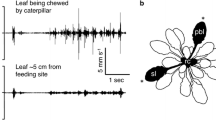Summary
During foraging, natural enemies of herbivores may employ volatile allelochemicals that originate from an interaction of the herbivore and its host plant. The composition of allelochemical blends emitted by herbivore-infested plants is known to be affected by both the herbivore and the plant. Our chemical data add new evidence to the recent notion that the plants are more important than the herbivore in affecting the composition of the volatile blends. Blends emitted by apple leaves infested with spider mites of 2 different species,T. urticae andP. ulmi, differed less in composition (principally quantitative differences for some compounds) than blends emitted by leaves of two apple cultivars infested by the same spider-mite species,T. urticae (many quantitative and a few qualitative differences). Comparison between three plant species — apple, cucumber and Lima bean — reveals even larger differences between volatile blends emitted upon spider-mite damage (many quantitative differences and several qualitative differences).
Similar content being viewed by others
References
Barbosa P (1988) Natural enemies and herbivore-plant interactions: influence of plant allelochemicals and host specificity. Pp 201–229in Barbosa P, Letourneau DK (eds) Novel Aspects of Insect-Plant Interactions. New York: Wiley & Sons
De Moraes GJ, McMurtry JA (1986) Suitability of the spider miteTetranychus evansi as prey forPhytoseiulus persimilis. Entomol exp appl 40:109–115
De Moraes GJ, McMurtry JA (1987) Physiological effect of the host plant on the suitability ofTetranychus urticae as prey forPhytoseiulus persimilis (Acari: Tetranychidae, Phytoseiidae). Entomophaga 32:35–38
Dicke M (1988) Prey preference of the phytoseiid miteTyphlodromus pyri: 1. Response to volatile kairomones. Exp Appl Acarol 4:1–13
Dicke M, Sabelis MW (1988) How plants obtain predatory mites as bodyguards. Neth J Zool 38:148–165
Dicke M, Sabelis MW (1989) Does it pay plants to advertize for bodyguards? Towards a cost-benefit analysis of induced synomone production. Pp 341–358in Lambers H, Cambridge ML, Konings H, Pons TL (eds) Causes and Consequences of Variation in Growth Rate and Productivity of Higher Plants. The Hague: SPB Acad Publ
Dicke M, Beek TA van, Posthumus MA, Ben Dom N, Bokhoven H van, De Groot Æ (1990a) Isolation and identification of volatile kairomone that affects acarine predator-prey interactions. Involvement of host in its production. J Chem Ecol 16:381–396
Dicke M, Maas K van der, Takabayashi J, Vet LEM (1990b) Learning affects response to volatile allelochemicals by predatory mites. Proc Exper Appl Entomol NEV (Amsterdam) 1:31–37
Dicke M, Sabelis MW, Takabayashi J, Bruin J, Posthumus MA (1990c) Plant strategies of manipulating predator-prey interactions through allelochemicals: prospects for application in pest control. J Chem Ecol 16:3091–3118
Haren RJF van, Steenhuis MM, Sabelis MW, De Ponti OMB (1987) Tomato stem trichomes and dispersal success ofPhytoseiulus persimilis relative to its preyTetranychus urticae. Exp Appl Acarol 3:115–121
Helle W, Sabelis MW (1985a) Spider Mites. Their Biology, Natural Enemies and Control. World Crop Pests Vol 1A. Amsterdam: Elsevier
Helle W, Sabelis MW (1985b) Spider Mites. Their Biology, Natural Enemies and Control. World Crop Pests Vol 1B. Amsterdam: Elsevier
Hulspas-Jordaan PM, Lenteren JC van (1978) The relationship between host-plant leaf structure and parasitization efficiency of the parasitic waspEncarsia formosa Gahan (Hymenoptera: Aphelinidae). Med Fac Landbouww Rijksuniv Gent 43:431–440
Masson C, Mustaparta H (1990) Chemical information processing in the olfactory system of insects. Physiol Rev 70:199–245
Obrycki JJ (1986) The influence of foliar pubescence on entomophagous species. Pp 61–83in Boethel DJ, Eikenbary RD (eds) Interactions of Plant Resistance and Parasitoids and Predators of Insects. Chichester: Ellis Horwood
Price PW, Bouton CE, Gross P, McPheron BA, Thompson JN, Weis AE (1980) Interactions among three trophic levels: influence of plant interactions between insect herbivores and natural enemies. Annu Rev Ecol Syst 11:41–65
Rabb RL, Bradley JR (1968) The influence of host plants on parasitism of eggs of the tobacco hornworm. J Econ Entomol 61:1249–1252
Sabelis MW, Dicke M (1985) Long-range dispersal and searching behaviour. Pp 141–160in Helle W, Sabelis MW (eds) Spider Mites. Their Biology, Natural Enemies and Control. World Crop Pests Vol 1B. Amsterdam: Elsevier
Sabelis MW, Van de Baan HE (1983) Location of distant spider mite colonies by phytoseiid predators: demonstration of specific kairomones emitted byTetranychus urticae andPanonychus ulmi. Entomol exp appl 33:303–314
Takabayashi J, Dicke M, Kemerink J, Veldhuizen T (1991) Environmental effects on production of a plant synomone that attracts predatory mites.In Jermy T, Szentesi A (eds) Insect-Plants 1989. Symposia Biologica Hungarica Vol 39: 541–542. Akademiai Kiado, Budapest, Hungary
Turlings TCJ, Scheepmaker JWA, Vet LEM, Tumlinson JH, Lewis WJ (1990a) How contact foraging experiences affect preferences of host-related odors in the larval parasitoidCotesia marginiventris (Cresson) (Hymenoptera: Braconidae). J Chem Ecol 16:1577–1589
Turlings TCJ, Tumlinson JH, Lewis WJ (1990b) Exploitation of herbivore-induced plant odors by host-seeking parasitic wasps. Science 250:1251–1253
Vet LEM (1988) The influence of learning on habitat location and acceptance by parasitoids. Colloq INRA 48:29–34
Vet LEM, Dicke M (1992) Ecology of infochemical use by natural enemies in a tritropic context. Annu Rev Entomol 37: in press
Vet LEM, Groenewold AW (1990) Semiochemicals and learning in parasitoids. J Chem Ecol 16:3119–3135
Visser JH (1986) Host odor perception by phytophagous insects. Annu Rev Entomol 31:121–144
Whitman DW, Eller FJ (1990) Parasitic wasps orient to green leaf volatiles. Chemoecology 1:69–75
Author information
Authors and Affiliations
Rights and permissions
About this article
Cite this article
Takabayashi, J., Dicke, M. & Posthumus, M.A. Variation in composition of predator-attracting allelochemicals emitted by herbivore-infested plants: Relative influence of plant and herbivore. Chemoecology 2, 1–6 (1991). https://doi.org/10.1007/BF01240659
Received:
Accepted:
Issue Date:
DOI: https://doi.org/10.1007/BF01240659




